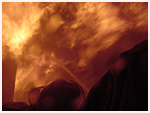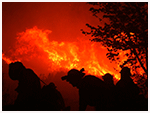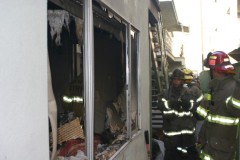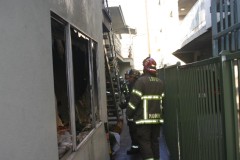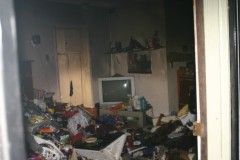By Jackawa Jackson | October 8, 2009
At 7:24 am on October 8, 2009, Long Beach Fire Department received a call to a reported structure fire located at 555 Cherry Ave. Residents were awakened to dense smoke pouring from the first floor apartment at this address. The female resident of the involved apartment was trapped inside due to “excessive hording conditions”, and the main body of fire that was located between the occupant and the front door. The resident was forced to climb to safety through a bathroom window and was assisted to the ground by passers-by. Long Beach Engine 2 arrived on scene within 3 minutes from the time of dispatch and found heavy smoke showing from the involved unit. Large amounts of combustibles were stacked, in some areas, to nearly half the height of the ceiling making it difficult to even open the front door. Fire units mounted an aggressive attack on the seat of the fire and managed to hold it to the room of origin. A thorough search was made of the apartment to ensure there were no other occupants inside. Extensive overhaul (search for hidden fire) was required due to the volume of combustibles on hand. There were no working smoke detectors in place at the time of the blaze. Long Beach Fire Department arson investigators were called in and determined the cause to be accidental. There were no reported injuries to civilian or firefighters. A total of 22 firefighters responded to this incident.
Topics: Incidents, News | 29 Comments »
By frhayes | October 8, 2009
| |
|
|
| |
| |
| |
Keep candles at least 12 inches from anything that can burn. |
| |
Use sturdy, safe candleholders. |
| |
Never leave a burning candle unattended. Extinguish candles when you leave a room. |
| |
Be careful not to splatter wax when extinguishing a candle. |
| |
Avoid using candles in bedrooms and sleeping areas. |
| |
Always use a flashlight, not a candle, for emergency lighting. |
| |
Consider using battery-operated flameless candles. |
|
|
|
During 2005, an estimated 15,600 home structure fires started by candles were reported to local fire departments. These fires resulted in an estimated 150 civilian deaths, 1,270 civilian injuries and an estimated direct property loss of $539 million. Homes include dwellings, duplexes, manufactured housing and apartments.
Facts and figures
- Although home candle fires fell 8% from 2004 to 2005, more than twice as many were reported in 2005 as in 1990.
- Candle fires accounted for an estimated 4% of all reported home fires in 2005.
- Thirty-eight percent (38%) of home candle fires started in the bedroom, resulting in 41% of the associated civilian deaths.
- December is the peak time of year for home candle fires. In December, 13% of home candle fires began with decorations compared to 4% the rest of the year.
- More than half of all candle fires started when something that could burn, such as furniture, mattresses or bedding, curtains, or decorations, was too close to the candle.
- Falling asleep was a factor in 12% of home candle fires and 26% of the associated deaths.
- The top five days for home candle fires were Christmas, Christmas Eve, New Year’s Day, New Year’s Eve, and Halloween.
Source: NFPA’s “Home Candle Fires” report by Marty Ahrens, September 2007. |
Topics: Public Safety | 6 Comments »
By frhayes | October 7, 2009
| |
|
|
|
|
|
|
|
| |
| |
| |
Escape planning
| |
| |
Draw a home escape plan and discuss it with everyone in your household. |
| |
Practice the plan night and day with everyone in your home twice a year. |
| |
Know at least two ways out of every room, if possible. Make sure all doors and windows leading outside open easily. |
| |
See all safety tips on escape planning. |
|
|
|
Fire can spread rapidly through your home, leaving you as little as two minutes to escape safely once the alarm sounds. Your ability to get out depends on advance warning from smoke alarms, and advance planning – a home fire escape plan that everyone in your family is familiar with and has practiced.
Facts and figures
- Only one-fifth to one-fourth of households (23%) have actually developed and practiced a home fire escape plan to ensure they could escape quickly and safely.
- In 2006, there were an estimated 396,000 reported home structure fires and 2,580 associated civilian deaths in the United States.
- One-thirdof American households who made an estimate thought they would have at least 6 minutes before a fire in their home would become life-threatening. The time available is often less.And only 8% said their first thought on hearing a smoke alarm would be to get out!Source:Harris Interactive Survey, Fall 2004(PDF, 759 KB).
|
|
| |
|
|
| In this Section: |
| |
|
|
|
|
|
|
|
|
|
|
|
Topics: Public Safety | 29 Comments »
By frhayes | October 6, 2009
|
|
| |
| |
| |
Store matches and lighters out of children’s reach and sight, up high, preferably in a locked cabinet. |
| |
Never use lighters or matches as a source of amusement for children; they may imitate you. |
| |
If your child expresses curiosity about fire or has been playing with fire, calmly but firmly explain that matches and lighters are tools for adults only. |
| |
Use only lighters designed with child-resistant features. Remember child-resistant does not mean child proof. |
| |
Teach young children to tell an adult if they see matches or lighters, and teach school-age children to bring any matches or lighters to an adult. |
| |
Never leave matches or lighters in a bedroom or any place where children may go without supervision. |
| |
If you suspect your child is intentionally setting fires or unduly fascinated with fire, get help. Your local fire department, school, or community counseling agency can put you in touch with trained experts. |
|
|
|
Children playing with fire cause hundreds of deaths and thousands of injuries each year. Preschoolers are most likely to start these fires, typically by playing with matches and lighters, and are most likely to die in them.
Facts & figures*
- In 2002, children playing with fire started an estimated 13,900 structure fires that were reported to U.S. fire departments, causing an estimated 210 civilian deaths, 1,250 civilian injuries and $339 million in direct property damage.
- The figures for 2002 structure fires, civilian deaths and civilian injuries are the lowest ever recorded.
- Most of the people killed in child-playing fires are under 5, and such fires are the leading cause of fire deaths among preschoolers.
- Roughly two out of every three child-playing fires — and three out of four associated deaths and injuries — involve matches or lighters.
- The child-playing fire problem has been smaller, relative to population, in Canada and much smaller in Japan.
- Children also start fires by playing with candles, fireworks, stoves and cigarettes.
- Among fatal home fires started by children playing, seven out of 10 involve children igniting bedding, mattresses, upholstered furniture or clothing.
- Just over half of child-playing fires in the home start in a bedroom.
- Children who start fires may be children in crisis, with the fires acting as cries for help from stressful life experiences or abuse, according to studies of fire-setting behavior.
- As of 2002, deaths in child-playing home structure fires had declined by roughly half since 1994, when the child-resistant lighter standard went into effect.
Source: NFPA’s “Children Playing with Fire” report by John R. Hall, Jr., April 2005. |
Topics: Public Safety | 22 Comments »
By frhayes | October 5, 2009
| Smoking material-related fires |
|
|
| |
|
|
|
| |
| |
| |
If you smoke, smoke outside. |
| |
Use deep, wide ashtrays on a sturdy table. |
| |
Before you throw out butts and ashes, make sure they are out, and dousing in water or sand is the best way to do that. |
| |
Check under furniture cushions and in other places people smoke for cigarette butts that may have fallen out of sight. |
| |
Never smoke in a home where oxygen is being used. |
| |
If you smoke, choose fire-safe cigarettes . They are less likely to cause fires. |
| |
To prevent a deadly cigarette fire, you have to be alert. You won’t be if you are sleepy, have been drinking, or have taken medicine or other drugs. |
| |
Keep matches and lighters up high, out of children’s sight and reach |
|
|
|
The Coalition for Fire-Safe Cigarettes, coordinated by NFPA, is calling for cigarette manufacturers to immediately produce only cigarettes that adhere to an established safety performance standard.
Facts & figures
- Smoking materials (i.e., cigarettes, cigars, pipes, etc.) are the leading cause of fire deaths in the United States. Roughly one of every four fire deaths in 2005 was attributed to smoking materials.
- In 2005, there were an estimated 82,400 smoking-material fires in the United States. These fires caused 800 civilian deaths and 1,660 civilian injuries.
- Older adults are at the highest risk of death or injury from smoking-material fires even though they are less likely to smoke than younger adults.
- The most common material first ignited in home smoking-material fire deaths were mattresses and bedding and upholstered furniture.
- In Canada there were 7,700 fires in 2002 associated with smoking materials. These fires caused 140 civilian deaths, 470 civilian injuries and direct property damage of $132 million Canadian ($84 million U.S. ).
Source: NFPA’s “The Smoking Material Fire Problem,” John R. Hall, Jr., November 2007.
Incidents
|
Topics: Public Safety | 30 Comments »
« Previous Entries
Next Entries »

